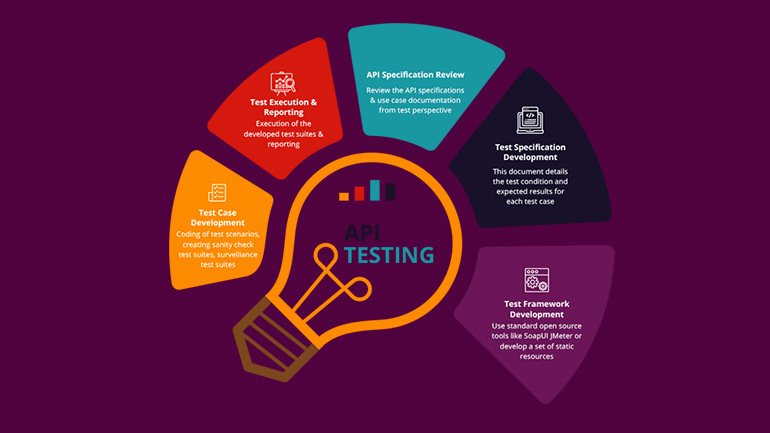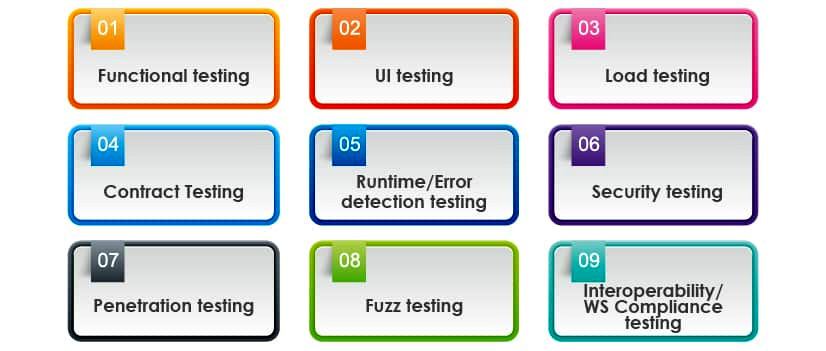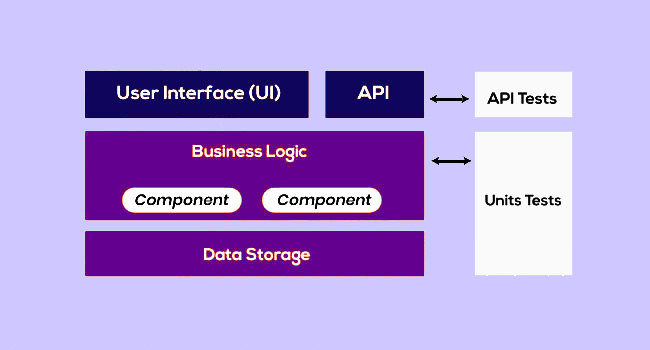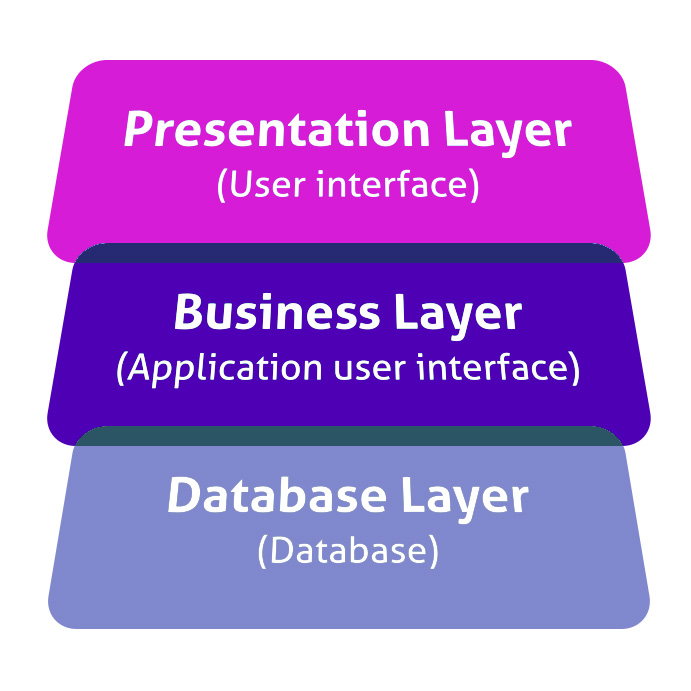How Do You Do API Testing in Real-Time?
API testing is a form of software testing/software test whose function is to analyze an application program interface (API) so as to verify that it fulfills the expected basic API functionality, performance, security, and reliability. These tests are performed either directly on the API or as a part of the integration testing. An API is a middleware code that enables two software programs so you can communicate with each other. The code can specify how an application requests services from the operating system (OS) or any other application.
Applications commonly encompass three layers; these are the data layer, the service layer (the API layer), and a presentation layer (the user interface – UI layer). The application’s business logic, which is the guide of how users can interact with the services, data, and functions held within the app, is found in the API layer. Web API testing focuses on the analysis of the business logic as well as the security of the application and data responses. An API test is usually performed by making requests to either a singular or several API endpoints and then comparing the answer with expected results. API testing is commonly automated and then used by DevOps, development teams, and quality assurance (QA) for continuous testing practices.
Table of Content:
- The Approach to API Testing
- The Kinds of API Tests
- The Importance of API Testing
- The Benefits of API Testing
- Testing Tools
The Approach to API Testing

The process when API testing should begin with a clearly defined scope of the program and a complete understanding of how the API is meant to work. Questions that testers should consider are highlighted below:
- What are the endpoints that are available for testing?
- What are the response codes that are expected for successful requests?
- What are the responses that are expected for unsuccessful bids?
- Which error message is likely to appear in the body when an unsuccessful bid comes through?
Once factors such as those highlighted above are understood, testers can begin applying various types of testing techniques. Test cases ought to be written for the API. These test cases are utilized to define the variables or conditions under which testers can determine whether a specific system performs correctly as well as responding appropriately. Once the test cases are specified, testers then perform and compare them to the expected results to the actual results. The test should be used to analyze responses such as the listed below:
- Data Quality
- HTTP Status Code
- Reply Time
- Confirmation of Authorization
- Error Codes
API testing is used to analyze several endpoints, such as databases or web user interfaces and services. Testers are expected to watch for failures or any unexpected inputs. The response time is likely to be within the acceptable agreed-upon limit, and the API is expected to be secured against potential attacks.
It is also expected that tests are constructed to ensure that users cannot affect the application in unexpected ways; the API is designed to handle the expected user load; additionally, the API is versatile enough to work across several browsers and devices. The test is also expected to analyze the results of non-functional tests, including performance and security.
The Kinds of API Tests

There is a range of general to specific analyses of the software. There are several types of API tests that can be performed to ensure the application programming interfaces are working as they should. Below are some of these types of tests:
Validation test comprises a few simple interview questions that address the entire project. The first set of questions are concerned with the product: was the right product built? Is the designed API the right product for the problem it attempts to resolve? Was there any significant code bloat found – meaning the production of code that is unnecessarily slow, wasteful, and long – throughout development that then pushes the API in an unsustainable direction.
The second set of questions is concerned with the API’s behavior: Is the right data being accessed in a predefined manner? Is there too much data that is being accessed? Is the data being accessed too much? Is the API storage working as it should, are the given set’s specific integrity and confidentiality requirements being met? The third set is concerned with the efficiency of the API: Is the API in question the most accurate and efficient methodology of performing a task? Is there any codebase that can be altered or removed entirely, reducing impairments and improving the overall service?
Functional testing is designed to ensure that the API is performing as it is meant to. This is a test that analyzes the specific functions found within the codebase, thus guaranteeing the API functions are within the expected input parameters and can handle the errors that occur when the results obtained are outside the designated parameters. This includes scenario tests to measure function.
Load testing is utilized to ascertain how many API calls an API is able to handle. The test is commonly performed after an entire codebase or a specific unit has been completed to determine whether the theoretical solution works as a practical solution when it is acting under a given load. This is data-driven testing, you act upon the results given.
Security testing comprises authorization checks, user rights management, and resource access validation. Security testing is commonly grouped with both fuzz testing and penetration testing in the more extraordinary security auditing process. Security testing brings together aspects of both fuzz tests and penetration testing; however, it also attempts to validate the encryption methods that API utilizes and the access control design.
Reliability testing ensures that the API produces consistent results and that the connection between the platform is constant.
Penetration testing, as mentioned before, builds upon security testing. This test allows the API to be attacked by a person with limited knowledge of the API. It enables the testers to analyze the attack vector from an outward perspective. The attacks that are utilized in penetration testing can target the API in its entirety limited or to specific elements of the API.
Fuzz testing is designed to forcibly input vast amounts of random data, and this is also referred to as noise or fuzz — into the system, thus attempting to create negative behavior, for example, a forced overflow or crash.
Regression tests are done to ensure that the software still functions as expected even after changes have been made to the source code.
The Importance of API Testing
- User interface tests are commonly inefficient when used to validate API service functionality testing and do not adequately cover the necessary aspects of back-end testing. There is a possibility of bugs being justify within the unit levels or the server, which is a costly mistake that can delay the product release significantly and will often require large amounts of code to be written all over again.
- API testing permits beginner developers to begin testing early in the development cycle prior to the UI test is ready. Requests that do not produce the appropriate value when at the server layer are not displayed on the UI layer. Enabling the developers to kill at least half if not more of the existing bugs prior to becoming a serious problem and enabling testers to make requests that may not pass through the UI – which is a necessity for exposing security flaws. You can also learn through API testing tutorials looking at introduction to API testing.
- Several companies are utilizing microservices for their software applications, and this is because they permit software to be deployed more efficiently. As one area of the app is being updated, the other areas can continue to function without any interruption. Individual application sections have different data stores and varying commands for interacting with that data store. Most microservices utilize APIs; therefore, as more businesses adopt the utility of microservices, API testing is becoming increasingly necessary to ensure all parts are working correctly as intended.
- API testing is equally crucial to Agile software development, in which instant feedback is essential to the testing process flow. When in Agile environments, unit tests and API tests are commonly preferred over the graphical user interface (GUI) tests because they are more efficient and easy to maintain. GUI tests typically require intense reworking if they are to keep pace with the frequent changes that occur in Agile testing environments.
Overall, integrating API tests into the test-driven development process can benefit development and engineering teams across the entire development lifecycle. The benefits are then passed along to your clients in the form of better-quality software products and improved services meeting your business requirements.
The Benefits of API Testing

When you have API testing (API Automation testing / API test automation or Manual testing), you are guaranteed that the connections between platforms are scalable, reliable, and safe. Specific benefits you experience include:
- You require less code than the automated GUI tests, which results in lower overall costs and faster testing.
- This live testing has enabled developers to access the app without having a UI, aiding the testers to identify errors early in the development lifecycle instead of waiting for them to become more significant problems. This allows you to save money due to the fact that it is more efficient to resolve when they are caught earlier.
- It is possible to integrate GUI tests with API tests. For instance, integration test allow new users to be created within the app prior to the GUI test being performed.
- Vulnerabilities are removed, and the app is guarded against breakage and malicious code because API tests utilize extreme conditions and inputs when analyzing applications.
- Data format is exchanged utilizing JSON or XML while containing HTTP requests and responses because API tests are language and technology-independent.
API testing presents these several benefits, and it also produces challenges. The typical limitations found in API tests are parameter combination, parameter selection, and call sequencing. Parameter selection requires the parameters sent via API requests to be validated — a process that can be difficult. Be that as it may, it is necessary that testers guarantee without fail that all parameter data meets the validation criteria that have been set, such as the use of appropriate string or numerical data and conformance with length restrictions and assigned value range.
It can be challenging to go through parameter combinations because every combination needs to be tested to see if it holds any problems related to the specific configurations. Another challenge is call sequencing because every call must appear in a particular order to be certain that the system works correctly. Quickly this becomes a challenge, especially when dealing with multithreaded applications.
Testing Tools

When you are performing an API test, as a developer, you can either write your own framework or choose one from a variety of ready-to-use API testing tools. Designing an API test framework enables developers to customize the test; they are not limited to the capabilities of a specific device and its plugins. It is possible for testers to add whichever library they consider appropriate for their choice of coding platform, incorporate complicated logic into the tests, and build unique and convenient reporting standards. But testers need sophisticated coding skills if they choose to design their own test frameworks.
Conversely, API testing tools provide you with user-friendly interfaces with minimal coding requirements thus, enabling less-experienced developers to feasibly deploy the tests. It is unfortunate, the management tools are often designed to analyze general API problems, and issues more specific to the tester’s API can easily go unnoticed.
Huge varieties of API automated testing tools are available, ranging from paid subscription tools to open source offerings. Some specific examples of API testing tools have been highlighted below:
- Katalon studio. An open-source application that helps with testing automated UI or automated UI testing.
- Apigee. This is a cloud API testing tool from Google that focuses on API performance testing.
- SoapUI. This tool focuses on testing APIs functionality in SOAP and REST APIs and web services.
- REST Assured. An open-source, Javascript, Java-specific language that facilitates and eases the testing of REST APIs.
- Postman. A Google chrome app is used for verifying and automating API testing.
- Apache JMeter. An open-source tool for load and functional API testing.
- Swagger UI. An open-source tool that creates a webpage that documents APIs used.
Examples of Tests (API)

The use cases of API testing are endless in nature; however, here are two examples of tests that you can perform to guarantee that the API is producing the appropriate results every time.
When users open any social media app or mobile apps, for instance, Twitter or Instagram, they are usually asked to log in. There are several ways this can be done: Firstly, independently, that is, through the app itself; secondly, via Google or Facebook. This implies that the social media app has an existing agreement with either Google or Facebook to access some level of user information that is already supplied to either of these two sources. APIs test ought then to be conducted to ensure that the social media app can collaborate with both Google and Facebook to pull the necessary information that enables the user access to the app using the login information that is provided from the other sources.
Another example in this testing scenario is the travel booking systems, for example, Expedia or Kayak. Users commonly expect all the cheapest flight options for a specific date to be available and displayed to them upon request when they are using a travel booking system. Generally, this requires the app to communicate with all the airlines available to find the best flight options for users. This is achieved through APIs. As a result, API tests need to be performed to ensure the travel booking system is successfully communicating as designed with the other companies and presenting the correct results to users in an appropriate time frame. Furthermore, if the user now chooses to book a flight and pays using a third-party payment service, for instance, PayPal or credit cards, then API tests need to be performed to guarantee the payment service and travel booking systems can effectively communicate as developed, process the payment, and keep the user’s sensitive data safe throughout the process. It could also work with an online travel service application, with third-party applications covered.
Best Practices

The API best practices have been highlighted below:
- Selected parameters should be included in the test case.
- When you are defending the test cases, you ought to group them by category.
- To monitor the API usability throughout step-by-step, you need to repeat and reuse tests in production.
- For better and more trustworthy results, use both manual and automated tests.
- Consistently note what does and does not happen.
- Load tests are required to test the API stress that is on the system.
- Develop and design test cases for all possible API input combinations ensuring complete test coverage.
- Have a solid plan when calling sequencing.
- Testing is made easier when you prioritize the API function calls.
- You should test the API for failures. You need to repeat a test until it has produced a failed output. Consistent failure helps you identify all the problems that are to be fixed.
- If possible, keep your test cases self-contained and away from dependencies.
- It is crucial to use a good level of documentation that is easily understood and the creation process automated.










